Chengfeng Zhao
Bottom-up Policy Optimization: Your Language Model Policy Secretly Contains Internal Policies
Dec 22, 2025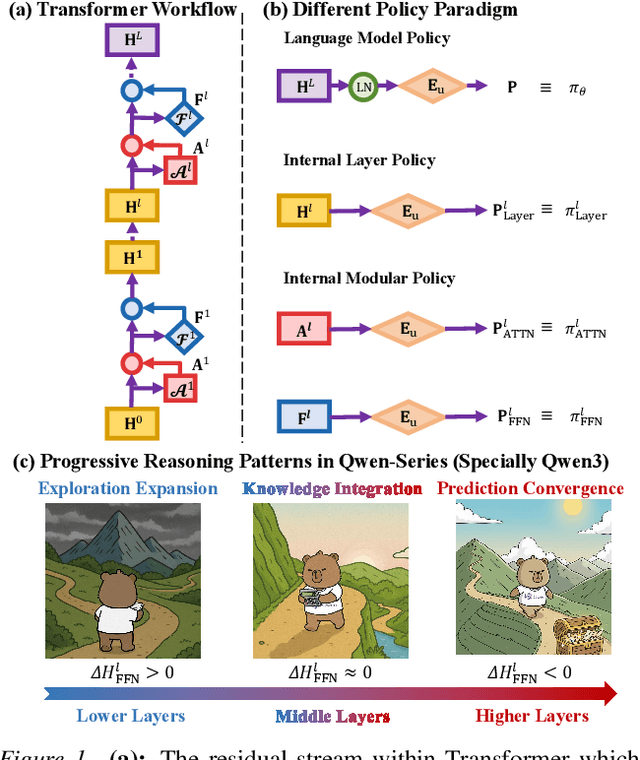
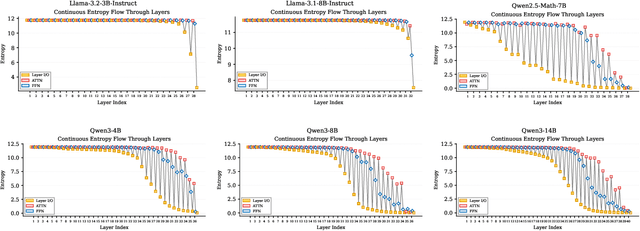
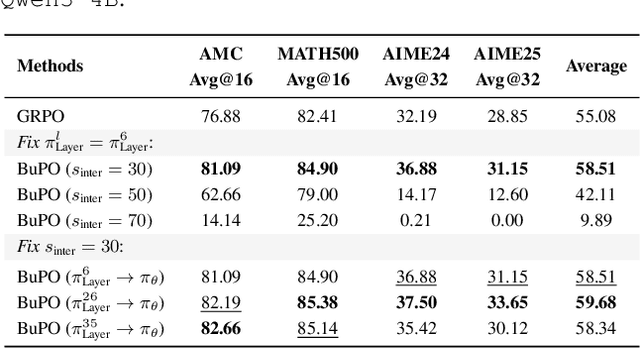
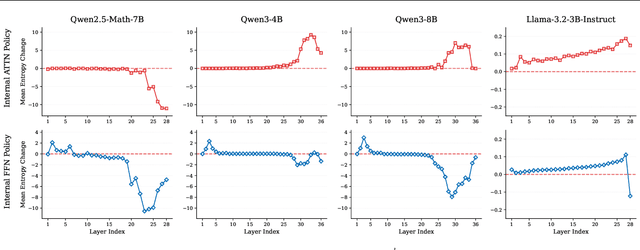
Abstract:Existing reinforcement learning (RL) approaches treat large language models (LLMs) as a single unified policy, overlooking their internal mechanisms. Understanding how policy evolves across layers and modules is therefore crucial for enabling more targeted optimization and raveling out complex reasoning mechanisms. In this paper, we decompose the language model policy by leveraging the intrinsic split of the Transformer residual stream and the equivalence between the composition of hidden states with the unembedding matrix and the resulting samplable policy. This decomposition reveals Internal Layer Policies, corresponding to contributions from individual layers, and Internal Modular Policies, which align with the self-attention and feed-forward network (FFN) components within each layer. By analyzing the entropy of internal policy, we find that: (a) Early layers keep high entropy for exploration, top layers converge to near-zero entropy for refinement, with convergence patterns varying across model series. (b) LLama's prediction space rapidly converges in the final layer, whereas Qwen-series models, especially Qwen3, exhibit a more human-like, progressively structured reasoning pattern. Motivated by these findings, we propose Bottom-up Policy Optimization (BuPO), a novel RL paradigm that directly optimizes the internal layer policy during early training. By aligning training objective at lower layer, BuPO reconstructs foundational reasoning capabilities and achieves superior performance. Extensive experiments on complex reasoning benchmarks demonstrates the effectiveness of our method. Our code is available at https://github.com/Trae1ounG/BuPO.
SyncHuman: Synchronizing 2D and 3D Generative Models for Single-view Human Reconstruction
Oct 09, 2025Abstract:Photorealistic 3D full-body human reconstruction from a single image is a critical yet challenging task for applications in films and video games due to inherent ambiguities and severe self-occlusions. While recent approaches leverage SMPL estimation and SMPL-conditioned image generative models to hallucinate novel views, they suffer from inaccurate 3D priors estimated from SMPL meshes and have difficulty in handling difficult human poses and reconstructing fine details. In this paper, we propose SyncHuman, a novel framework that combines 2D multiview generative model and 3D native generative model for the first time, enabling high-quality clothed human mesh reconstruction from single-view images even under challenging human poses. Multiview generative model excels at capturing fine 2D details but struggles with structural consistency, whereas 3D native generative model generates coarse yet structurally consistent 3D shapes. By integrating the complementary strengths of these two approaches, we develop a more effective generation framework. Specifically, we first jointly fine-tune the multiview generative model and the 3D native generative model with proposed pixel-aligned 2D-3D synchronization attention to produce geometrically aligned 3D shapes and 2D multiview images. To further improve details, we introduce a feature injection mechanism that lifts fine details from 2D multiview images onto the aligned 3D shapes, enabling accurate and high-fidelity reconstruction. Extensive experiments demonstrate that SyncHuman achieves robust and photo-realistic 3D human reconstruction, even for images with challenging poses. Our method outperforms baseline methods in geometric accuracy and visual fidelity, demonstrating a promising direction for future 3D generation models.
Reconstructing 4D Spatial Intelligence: A Survey
Jul 28, 2025



Abstract:Reconstructing 4D spatial intelligence from visual observations has long been a central yet challenging task in computer vision, with broad real-world applications. These range from entertainment domains like movies, where the focus is often on reconstructing fundamental visual elements, to embodied AI, which emphasizes interaction modeling and physical realism. Fueled by rapid advances in 3D representations and deep learning architectures, the field has evolved quickly, outpacing the scope of previous surveys. Additionally, existing surveys rarely offer a comprehensive analysis of the hierarchical structure of 4D scene reconstruction. To address this gap, we present a new perspective that organizes existing methods into five progressive levels of 4D spatial intelligence: (1) Level 1 -- reconstruction of low-level 3D attributes (e.g., depth, pose, and point maps); (2) Level 2 -- reconstruction of 3D scene components (e.g., objects, humans, structures); (3) Level 3 -- reconstruction of 4D dynamic scenes; (4) Level 4 -- modeling of interactions among scene components; and (5) Level 5 -- incorporation of physical laws and constraints. We conclude the survey by discussing the key challenges at each level and highlighting promising directions for advancing toward even richer levels of 4D spatial intelligence. To track ongoing developments, we maintain an up-to-date project page: https://github.com/yukangcao/Awesome-4D-Spatial-Intelligence.
Mojito: LLM-Aided Motion Instructor with Jitter-Reduced Inertial Tokens
Feb 22, 2025Abstract:Human bodily movements convey critical insights into action intentions and cognitive processes, yet existing multimodal systems primarily focused on understanding human motion via language, vision, and audio, which struggle to capture the dynamic forces and torques inherent in 3D motion. Inertial measurement units (IMUs) present a promising alternative, offering lightweight, wearable, and privacy-conscious motion sensing. However, processing of streaming IMU data faces challenges such as wireless transmission instability, sensor noise, and drift, limiting their utility for long-term real-time motion capture (MoCap), and more importantly, online motion analysis. To address these challenges, we introduce Mojito, an intelligent motion agent that integrates inertial sensing with large language models (LLMs) for interactive motion capture and behavioral analysis.
HOI-M3:Capture Multiple Humans and Objects Interaction within Contextual Environment
Apr 02, 2024



Abstract:Humans naturally interact with both others and the surrounding multiple objects, engaging in various social activities. However, recent advances in modeling human-object interactions mostly focus on perceiving isolated individuals and objects, due to fundamental data scarcity. In this paper, we introduce HOI-M3, a novel large-scale dataset for modeling the interactions of Multiple huMans and Multiple objects. Notably, it provides accurate 3D tracking for both humans and objects from dense RGB and object-mounted IMU inputs, covering 199 sequences and 181M frames of diverse humans and objects under rich activities. With the unique HOI-M3 dataset, we introduce two novel data-driven tasks with companion strong baselines: monocular capture and unstructured generation of multiple human-object interactions. Extensive experiments demonstrate that our dataset is challenging and worthy of further research about multiple human-object interactions and behavior analysis. Our HOI-M3 dataset, corresponding codes, and pre-trained models will be disseminated to the community for future research.
LiveHPS: LiDAR-based Scene-level Human Pose and Shape Estimation in Free Environment
Feb 27, 2024Abstract:For human-centric large-scale scenes, fine-grained modeling for 3D human global pose and shape is significant for scene understanding and can benefit many real-world applications. In this paper, we present LiveHPS, a novel single-LiDAR-based approach for scene-level human pose and shape estimation without any limitation of light conditions and wearable devices. In particular, we design a distillation mechanism to mitigate the distribution-varying effect of LiDAR point clouds and exploit the temporal-spatial geometric and dynamic information existing in consecutive frames to solve the occlusion and noise disturbance. LiveHPS, with its efficient configuration and high-quality output, is well-suited for real-world applications. Moreover, we propose a huge human motion dataset, named FreeMotion, which is collected in various scenarios with diverse human poses, shapes and translations. It consists of multi-modal and multi-view acquisition data from calibrated and synchronized LiDARs, cameras, and IMUs. Extensive experiments on our new dataset and other public datasets demonstrate the SOTA performance and robustness of our approach. We will release our code and dataset soon.
I'M HOI: Inertia-aware Monocular Capture of 3D Human-Object Interactions
Dec 10, 2023
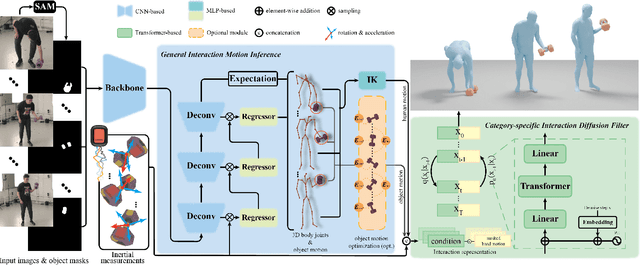
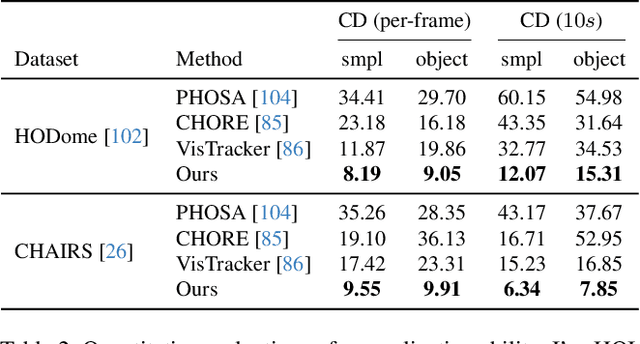
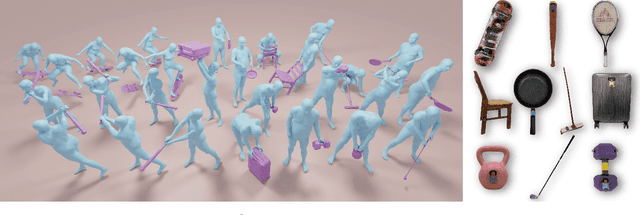
Abstract:We are living in a world surrounded by diverse and "smart" devices with rich modalities of sensing ability. Conveniently capturing the interactions between us humans and these objects remains far-reaching. In this paper, we present I'm-HOI, a monocular scheme to faithfully capture the 3D motions of both the human and object in a novel setting: using a minimal amount of RGB camera and object-mounted Inertial Measurement Unit (IMU). It combines general motion inference and category-aware refinement. For the former, we introduce a holistic human-object tracking method to fuse the IMU signals and the RGB stream and progressively recover the human motions and subsequently the companion object motions. For the latter, we tailor a category-aware motion diffusion model, which is conditioned on both the raw IMU observations and the results from the previous stage under over-parameterization representation. It significantly refines the initial results and generates vivid body, hand, and object motions. Moreover, we contribute a large dataset with ground truth human and object motions, dense RGB inputs, and rich object-mounted IMU measurements. Extensive experiments demonstrate the effectiveness of I'm-HOI under a hybrid capture setting. Our dataset and code will be released to the community.
LiDAR-aid Inertial Poser: Large-scale Human Motion Capture by Sparse Inertial and LiDAR Sensors
May 30, 2022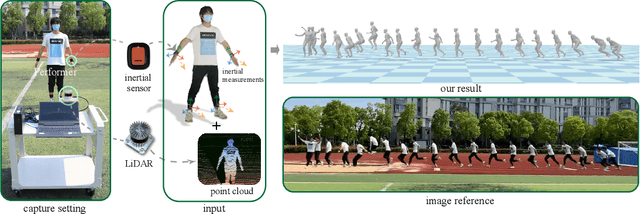

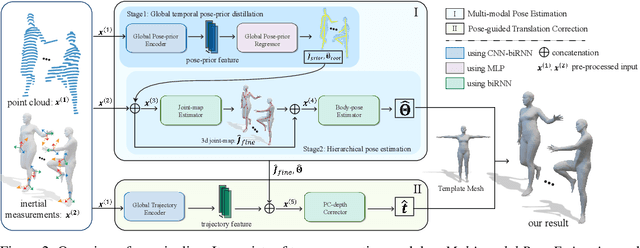
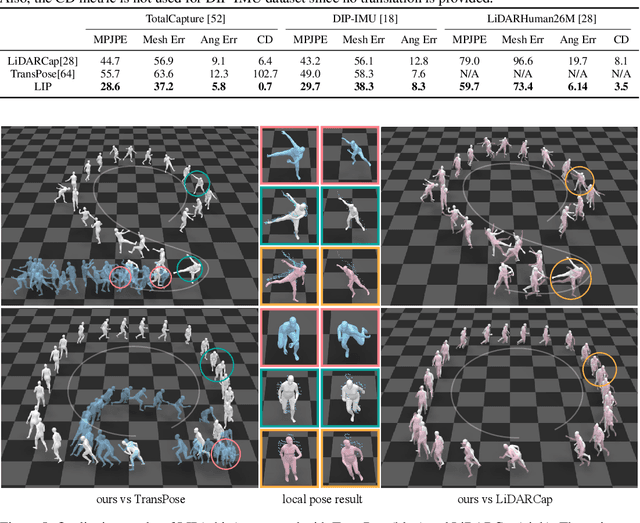
Abstract:We propose a multi-sensor fusion method for capturing challenging 3D human motions with accurate consecutive local poses and global trajectories in large-scale scenarios, only using a single LiDAR and 4 IMUs. Specifically, to fully utilize the global geometry information captured by LiDAR and local dynamic motions captured by IMUs, we design a two-stage pose estimator in a coarse-to-fine manner, where point clouds provide the coarse body shape and IMU measurements optimize the local actions. Furthermore, considering the translation deviation caused by the view-dependent partial point cloud, we propose a pose-guided translation corrector. It predicts the offset between captured points and the real root locations, which makes the consecutive movements and trajectories more precise and natural. Extensive quantitative and qualitative experiments demonstrate the capability of our approach for compelling motion capture in large-scale scenarios, which outperforms other methods by an obvious margin. We will release our code and captured dataset to stimulate future research.
HybridCap: Inertia-aid Monocular Capture of Challenging Human Motions
Mar 17, 2022

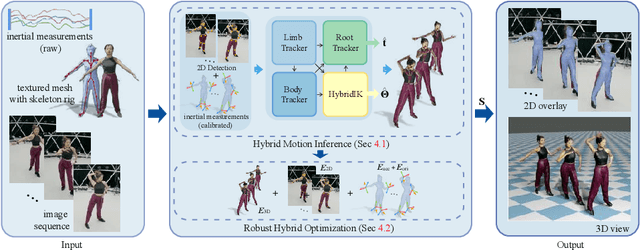

Abstract:Monocular 3D motion capture (mocap) is beneficial to many applications. The use of a single camera, however, often fails to handle occlusions of different body parts and hence it is limited to capture relatively simple movements. We present a light-weight, hybrid mocap technique called HybridCap that augments the camera with only 4 Inertial Measurement Units (IMUs) in a learning-and-optimization framework. We first employ a weakly-supervised and hierarchical motion inference module based on cooperative Gated Recurrent Unit (GRU) blocks that serve as limb, body and root trackers as well as an inverse kinematics solver. Our network effectively narrows the search space of plausible motions via coarse-to-fine pose estimation and manages to tackle challenging movements with high efficiency. We further develop a hybrid optimization scheme that combines inertial feedback and visual cues to improve tracking accuracy. Extensive experiments on various datasets demonstrate HybridCap can robustly handle challenging movements ranging from fitness actions to Latin dance. It also achieves real-time performance up to 60 fps with state-of-the-art accuracy.
 Add to Chrome
Add to Chrome Add to Firefox
Add to Firefox Add to Edge
Add to Edge